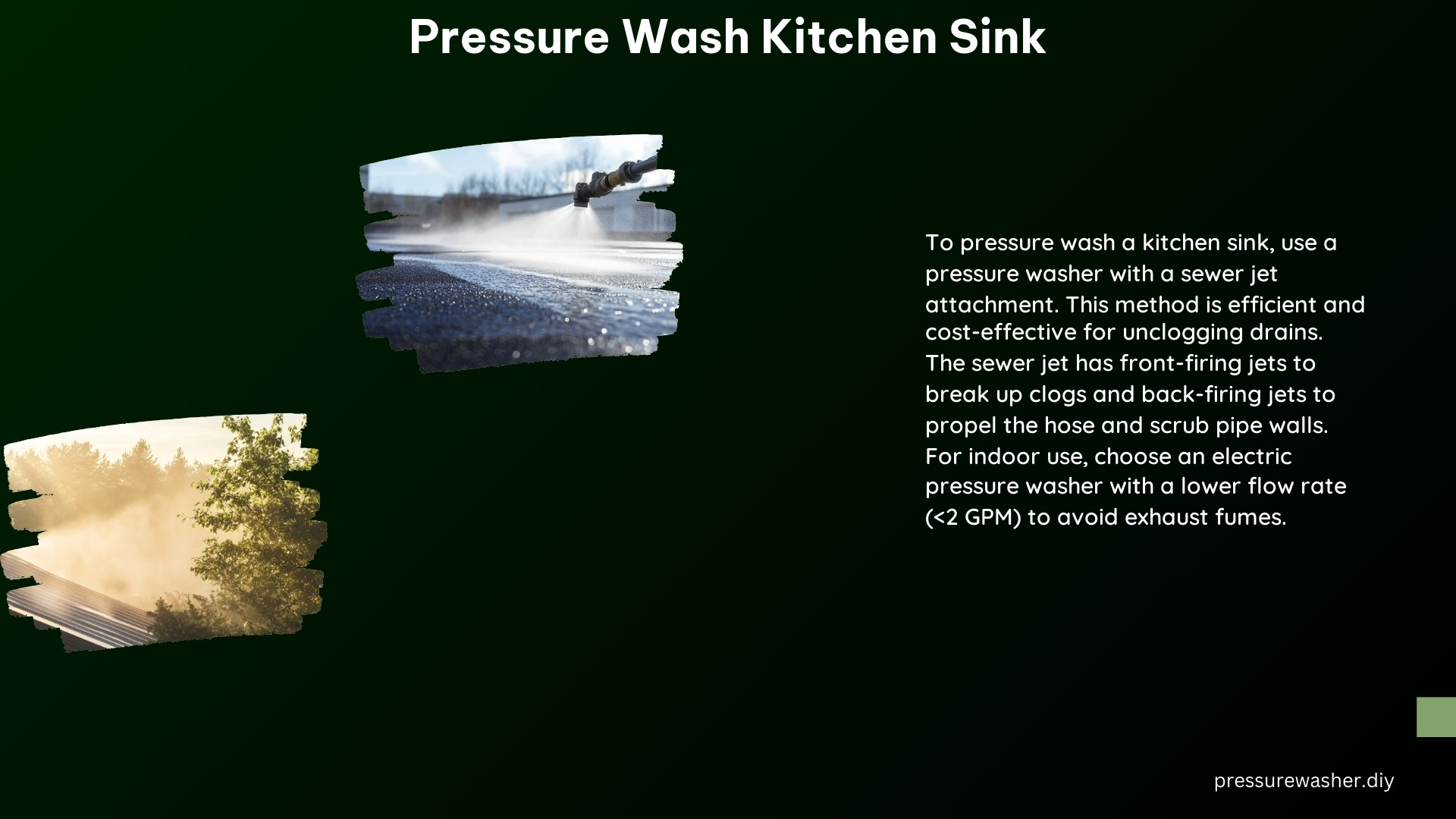Pressure washing a kitchen sink can be an effective and efficient way to unclog and clean your drain, saving you time and money compared to traditional methods like chemical drain cleaners or plumbing augers. This comprehensive guide will provide you with the technical specifications, safety considerations, and step-by-step instructions to pressure wash your kitchen sink effectively.
Can I Use a Pressure Washer to Unclog My Kitchen Sink?
Absolutely! Using a pressure washer with a sewer jet attachment is an excellent way to unclog your kitchen sink. This method is highly effective at breaking up and flushing out stubborn clogs, leaving your pipes cleaner and less prone to future blockages.
The key to success is using the right pressure washer and sewer jet attachment. A pressure washer with a minimum of 1,600 PSI (pounds per square inch) is recommended for unclogging kitchen sink drains. The sewer jet attachment is a crucial component, as it includes a long, flexible hose with a jet nozzle on one end and a coupling that attaches to the pressure washer on the other.
How Do I Connect a Pressure Washer to My Kitchen Sink Faucet?

Connecting a pressure washer to your kitchen sink faucet is a straightforward process, but it’s essential to have the right equipment. Here’s a step-by-step guide:
-
Obtain a Sewer Jet Attachment: This attachment is specifically designed for unclogging drains and pipes. It consists of a long, flexible hose with a jet nozzle on one end and a coupling that attaches to your pressure washer on the other.
-
Attach the Sewer Jet Attachment: Connect the coupling end of the sewer jet attachment to the pressure washer’s outlet. Ensure a tight and secure connection to prevent any leaks.
-
Insert the Jet Nozzle into the Sink Drain: Carefully insert the jet nozzle end of the sewer jet attachment into the kitchen sink drain. Make sure it’s fully inserted and positioned to effectively target the clog.
-
Turn on the Pressure Washer: Start the pressure washer and allow the water to flow through the sewer jet attachment. The high-pressure water will break up the clog and flush it out of the drain.
-
Adjust the Pressure and Flow Rate: Experiment with different pressure and flow rate settings to find the most effective combination for your specific clog. Start with a lower setting and gradually increase the pressure as needed.
Remember, it’s essential to follow all safety guidelines when using a pressure washer, including wearing protective gear and ensuring the area is clear of obstacles.
Technical Specifications for Pressure Wash Kitchen Sink
To ensure a successful and safe pressure washing experience, it’s crucial to understand the technical specifications required for the task. Here are the key details:
Pressure Washer Requirements
- Minimum Pressure: 1,600 PSI (pounds per square inch)
- Recommended Flow Rate: 1.5 to 2.0 GPM (gallons per minute)
- Power Source: Electric pressure washers are preferred for indoor use as they do not produce exhaust fumes. They typically have a lower flow rate (less than 2 GPM) compared to gas-powered models.
Sewer Jetter Attachment
- Hose Length: The sewer jet attachment should have a long, flexible hose (typically 25 to 50 feet) to reach the kitchen sink drain effectively.
- Nozzle Design: The jet nozzle should have both front-firing and back-firing jets. The front-firing jets break up the clog, while the back-firing jets propel the hose through the drain and scrub the pipe walls.
- Coupling: The attachment should have a secure coupling that easily connects to the pressure washer’s outlet.
High Pressure Sink Sprayers
In addition to using a pressure washer with a sewer jet attachment, you can also consider high-pressure sink sprayers for cleaning and maintaining your kitchen sink.
Commercial Sink Sprayers
- Pressure Rating: Commercial sink sprayers are designed for heavy-duty use in commercial kitchens and can deliver high pressure, up to 1.42 GPM, for effective cleaning.
- Features: These sprayers often have flexible stainless steel hoses, multiple spray modes, and durable construction to withstand frequent use.
Residential Sink Sprayers
- Pressure Rating: Residential high-pressure sink sprayers typically have a pressure rating between 80 to 120 PSI, providing a powerful cleaning solution for home kitchens.
- Features: Residential models may include features like flexible hoses, adjustable spray patterns, and ergonomic designs for comfortable use.
DIY and Safety Considerations
When pressure washing your kitchen sink, it’s essential to prioritize safety and follow best practices to ensure a successful and safe experience. Here are some key considerations:
Safety Precautions
- Wear Protective Gear: Always wear safety goggles, gloves, and appropriate clothing when using a pressure washer to protect yourself from water spray and debris.
- Clear the Area: Ensure the work area is clear of any obstacles or items that could be damaged by the high-pressure water.
- Proper Ventilation: If using a gas-powered pressure washer, make sure the area is well-ventilated to prevent the buildup of exhaust fumes.
DIY Tips
- Use the Sewer Jet Attachment: Invest in a high-quality sewer jet attachment specifically designed for unclogging drains. This will ensure the most effective and efficient cleaning.
- Clean Thoroughly: After using the pressure washer, make sure to thoroughly clean the sink and surrounding area to prevent any residual debris from causing future clogs.
- Maintain the Pressure Washer: Regular maintenance of your pressure washer, including cleaning the nozzle and checking for any wear or damage, will help ensure its longevity and optimal performance.
By following these technical specifications, safety guidelines, and DIY tips, you can effectively pressure wash your kitchen sink and keep your drains flowing smoothly.
Reference:
- https://www.youtube.com/watch?v=34UgjaY8nUc
- https://www.amazon.com/high-pressure-sink-sprayer/s?k=high+pressure+sink+sprayer
- https://trusteyman.com/blog/unclogging-the-drain-should-you-use-a-pressure-washer/
- https://www.youtube.com/watch?v=dk2svSkxPXw
- https://www.reddit.com/r/Tools/comments/9qxf4a/anyone_know_of_a_small_sinkmounted_pressure/
